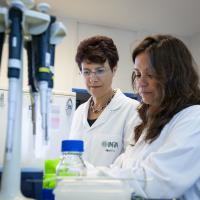
Food, Global Health Reading time 6 min
Isabelle Oswald: A toxin heroine
Published on 05 December 2018
Above all else, Isabelle Oswald loves research. Immunology, toxicology, mycology: Isabelle dives into every discipline and research topic with the same passion and commitment. “Loving my job is a luxury that I appreciate on a daily basis.” After joining INRA in 1994, Isabelle jumped straight into the world of mycotoxins under the leadership of Joseph Le Bars and his infectious enthusiasm for the mould toxins present in 50% of the food we eat. These toxins have been the cause of spectacular pathologies in humans, including ‘St Anthony’s Fire’, a condition caused by ergot poisoning, a mould found in rye, and even cancer, caused by eating peanuts containing aflatoxin. Mycotoxins continue to have a major impact on human and animal health; their multiple effects and proliferation still defy science. This challenge takes on new importance in a context of global warming conducive to the development of moulds.
Groundbreaking results
Understanding mycotoxins: a public health challenge
As an immunologist and agronomic engineer, Isabelle initially focused her work on vaccination using swine as a target animal and model for humans. Her first noteworthy finding showed that mycotoxins can reduce vaccine response and that, as a result, certain vaccination failures, in both animals and humans, were caused by contaminated ingested food: a link previously unexplored. Isabelle’s second breakthrough was to establish that certain mycotoxins affect the intestine’s ability to play its role as a selective and protective barrier, showing that food contaminants, even at small doses, can have damaging long-term effects on health.
Key challenges for public health
Isabelle currently heads a team of twenty people at an internationally reputed research unit. Part of this team works on the biosynthesis of mycotoxins, and the other on the characterisation of their toxicity. “Our current challenge concerns the effects of mycotoxins combined with other contaminants such as heavy metals. Through a varied diet we are exposed to contaminants, albeit in very small doses but which accumulate and sometimes create ‘cocktail effects’”. Regulation must evolve to take into account these combinations. Another challenge is to know more: only 20% of the molecules produced by fungi have been identified, and furthermore, the metabolites of certain mycotoxins turn out to be more toxic than the mycotoxins themselves. One example is aflatoxin, the strongest natural carcinogen currently known to scientists. Isabelle lends her expertise to the French Agency for Food, Environmental and Occupational Health & Safety (ANSES) and the EFSA, which assess the risks linked to the presence of contaminants in food.
Test tube tinkering...by proxy
In a simple, upbeat manner, without a speck of defeatism in her cheerful expression, Isabelle describes in crystal clear terms her areas of study and her results, punctuating what she says with a decidedly reassuring ‘that’s it’. Her mischievous and curious eyes glint darkly as she admits to the great pleasure of following the daily ins and outs of her colleagues’ experiments. “It really feels like I'm at the workbench even though I'm not”. Attentive and approachable, she always stops what she’s doing when a colleague stops by her office. Isabelle’s lab is a model of cooperation and collective effort. A library of common protocols is available to all and upcoming experiments are discussed by the team every week.
“I’m very happy to receive the Laurier: it rewards 20 years of work by an entire team. It was a pleasant surprise.” Modest but swift, Isabelle wins the Lifetime Achievement Award at 56, after a rapid and steady ascent from the position of research scientist to research director.
56 years old, married, two children
Career:- 1986: Engineering degree, ENSA Rennes
- 1990: Doctorate, Université de Rennes I
- 1990-1994: Post-doctoral studies, National Institutes of Health, Bethesda, USA
- 1993-2018: INRA, TOXALIM Joint Research Unit, Toulouse Researcher (Class 2) (1996), (Class 1) (1997), Director of Research (DR2) (2005), (DR1) (2010)
- Consultant for ANSES, EFSA, ILSI and IARC
- Member of the peer review committees of 9 scientific journals, editor on international publications and projects
- Winner of the Order of Agricultural Merit (2010)
- Hobbies: collecting small pig figurines and pictures from around the world
